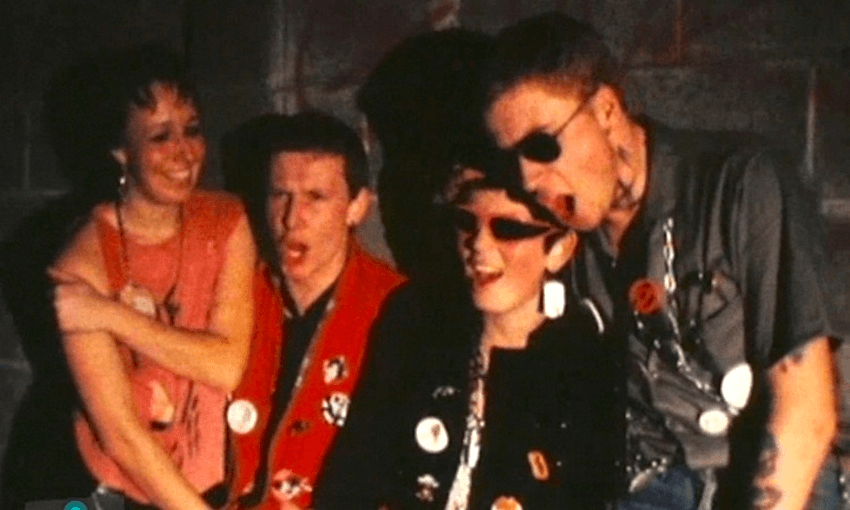Before there was Flying Nun, there was the NZ punk scene. To celebrate NZ Music Month, Gareth Shute looks back at a 1978 snapshot of the birth of our local indie scene.
It was June 1978 when promoter Derek King made a plan for half-a-dozen bands from Auckland to drive south for a Punk Spectacular at the Wellington Town Hall. Most of the bands were regulars at Parnell punk hangout, Zwines, though two of the acts – the Idol Idles and Rooter – had been together for less than a month.
There were only two television channels in those days. TVNZ correspondent Dylan Taite had already broadcast a much-talked-about exposé on English punk the year before. Reporter Neil Roberts perhaps thought that covering the tour for the current affairs show Eyewitness would be a great way to stir up more outrage about the shocking new subculture.
It wasn’t easy being a punk at this end of the world in those days. The music magazines from the UK took months to arrive and only a smattering of records were available, so it was hard to get a sense of what the new musical form actually sounded like.
The most consistent fashion statement in the Eyewitness report is scrawled messages on T-shirts (or skin) in vivid marker: “ROOTER”, “SCAVS” (shorthand for Auckland band, The Scavengers), “ELVIS P IS DEAD, LONG LIVE ELVIS C – ZWINES” (Costello taking the place of Presley), and this rather pointed message to the film crew…
It’s also entertaining to see Roberts so taken aback at finding everyone in the scene wearing sneakers – it’s now hard to imagine most people at a gig wearing anything else. Yet the punks certainly did chafe against mainstream culture at the time and the interviewees are only too happy to recount stories of being chased by “beeries” (rugby-players, rednecks).
Here’s lead singer of The Doomed, Johnny Abort (aka Richard Driver), doing his best sneer for the camera:
The music featured is pretty straightforward rock’n’roll (despite the snarled vocals) and yet the protagonists all speak of their moves from ‘punk’ to ‘new wave’ to ‘power pop’ – fine differences that are trickier to define at this remove. The most jarring aspect of the documentary to a contemporary viewer is the fact that so many of the interview subjects smoke cigarettes continually while on camera.
One of these smokers was Kerry Buchanan (aka Eddie Clanger), the drummer from Rooter. I asked him what he remembers about the filming of the documentary. He recalls being cynical about Roberts’ motives at the time.
“They just did it because of the media interest in punk rock in the UK at the time. ‘Punk is crazy, wacky stuff.’ I don’t think the piece was even music-related,” he said.
“But even a piece like that does manage to capture some of the truth of what was going on – whether it was just the shots of what the people looked like in the audience. I don’t know if we really thought about the TV thing being a big deal in that we were arrogant little shits really. We were basically fans more than a band at that point. You don’t know when you’re doing something like that, that it will later become a historical document.”
The most high profile act on the tour was The Suburban Reptiles, who were already onto their second line-up after just one year in existence (interesting to note that Joel Little’s mum – Trish Scott aka Sissy Spunk – had been their original guitarist).
The band’s manager, Simon Grigg, recalls being bemused when a film crew arrived at his house to shoot some footage.
“The scene was active and thriving (although not massive) and then this guy turned up and announced he was going to make it famous. I remember everyone taking the piss out of Neil Roberts and him not quite understanding – or so we thought. The ‘girls being interviewed in bed’ stuff was regarded as somewhat sleazy as I recall but the whole scene was used to dealing with outsiders having that approach. It attracted a lot of oddballs.”
Despite the sensationalism of the Eyewitness report, it did manage to document the early moments of a scene that would spawn many influential players in the local music industry. Kerry Buchanan went on to play in the Terrorways next, though his more longterm influence was as a music journalist; he wrote the hip hop column in Real Groove magazine for many years. Richard Driver went on to join the new wave group Pop Mechanix, though he gained his greatest fame during the following decade as host of Radio With Pictures (he’s now the chairman of Greenstone TV).
Simon Grigg went on to form the post-punk label Propeller Records, before moving into dance music. He opened Auckland clubs The Box and Cause Celebre and launched a new label, Huh! which released the worldwide smash ‘How Bizarre’ by OMC. Bones Hillman was equally successful, initially joining other ex-members of The Suburban Reptiles, Buster Stiggs and Phil Judd, in The Swingers who had a No.1 on both sides of the Tasman with ‘Counting The Beat’. Later, Hillman would move to Australia to join Aussie rock heavyweights Midnight Oil.
What’s probably more important than these individual contributions is that the early punk scene showed that anyone could form a label, open a venue or start a band. Many did, and the local indie scene truly got underway when Flying Nun arrived soon after. In this respect, watching the Eyewitness report now has the same effect as when it was first broadcast – the musicians seem so half-arsed that you feel like you could just as easily form a band or label yourself. Why not give it a try?
